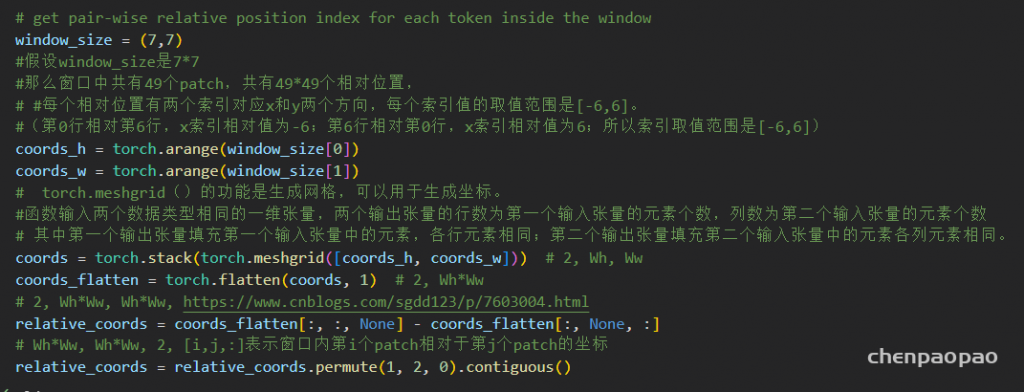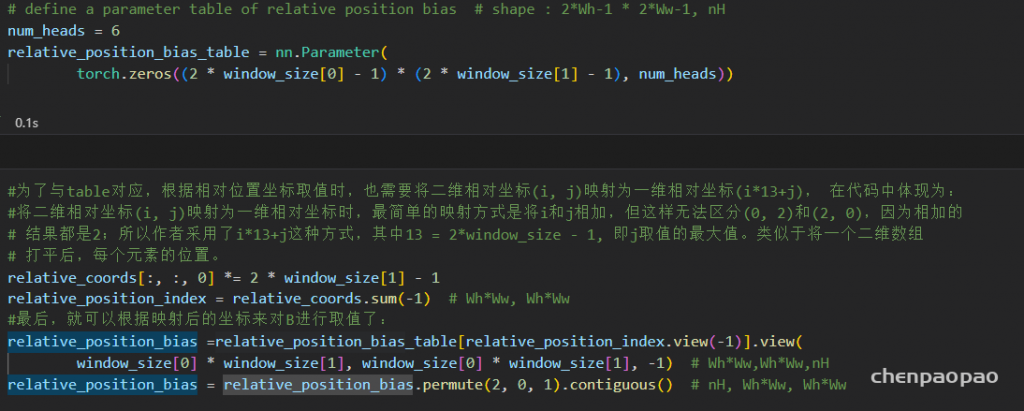code:https://github.com/microsoft/Swin-Transformer
代码详解: https://zhuanlan.zhihu.com/p/367111046

预处理:
对于分类模型,输入图像尺寸为 224×224×3 ,即 H=W=224 。按照原文描述,模型先将图像分割成每块大小为 4×4 的patch,那么就会有 56×56 个patch,这就是初始resolution,也是后面每个stage会降采样的维度。后面每个stage都会降采样时长宽降到一半,特征数加倍。按照原文及原图描述,划分的每个patch具有 4×4×3=48 维特征。
- 实际在代码中,首先使用了PatchEmbed模块(这里的PatchEmbed包括上图中的Linear Embedding 和 patch partition层),定义如下:
class PatchEmbed(nn.Module):
def __init__(self, img_size=224, patch_size=4, in_chans=3, embed_dim=96, norm_layer=None): # embed_dim就是上图中的C超参数
super().__init__()
img_size = to_2tuple(img_size)
patch_size = to_2tuple(patch_size)
patches_resolution = [img_size[0] // patch_size[0], img_size[1] // patch_size[1]]
self.img_size = img_size
self.patch_size = patch_size
self.patches_resolution = patches_resolution
self.num_patches = patches_resolution[0] * patches_resolution[1]
self.in_chans = in_chans
self.embed_dim = embed_dim
self.proj = nn.Conv2d(in_chans, embed_dim, kernel_size=patch_size, stride=patch_size)
if norm_layer is not None:
self.norm = norm_layer(embed_dim)
else:
self.norm = None
def forward(self, x):
B, C, H, W = x.shape
# FIXME look at relaxing size constraints
assert H == self.img_size[0] and W == self.img_size[1], \
f"Input image size ({H}*{W}) doesn't match model ({self.img_size[0]}*{self.img_size[1]})."
x = self.proj(x).flatten(2).transpose(1, 2) # B Ph*Pw C
if self.norm is not None:
x = self.norm(x)
return x可以看到,实际操作使用了一个卷积层conv2d(3, 96, 4, 4),直接就做了划分patch和编码初始特征的工作,对于输入 x:B×3×224×224 ,经过一层conv2d和LayerNorm得到 x:B×562×96 。然后作为对比,可以选择性地加上每个patch的绝对位置编码,原文实验表示这种做法不好,因此不会采用(ape=false)。最后经过一层dropout,至此,预处理完成。另外,要注意的是,代码和上面流程图并不符,其实在stage 1之前,即预处理完成后,维度已经是 H/4×W/4×C ,stage 1之后已经是 H/8×W/8×2C ,不过在stage 4后不再降采样,得到的还是 H/32×W/32×8C 。
stage处理
我们先梳理整个stage的大体过程,把简单的部分先说了,再深入到复杂得的细节。每个stage,即代码中的BasicLayer,由若干个block组成,而block的数目由depth列表中的元素决定。每个block就是W-MSA(window-multihead self attention)或者SW-MSA(shift window multihead self attention),一般有偶数个block,两种SA交替出现,比如6个block,0,2,4是W-MSA,1,3,5是SW-MSA。在经历完一个stage后,会进行下采样,定义的下采样比较有意思。比如还是 56×56 个patch,四个为一组,分别取每组中的左上,右上、左下、右下堆叠一起,经过一个layernorm,linear层,实现维度下采样、特征加倍的效果。实际上它可以看成一种加权池化的过程。代码如下:
class PatchMerging(nn.Module):
def __init__(self, input_resolution, dim, norm_layer=nn.LayerNorm):
super().__init__()
self.input_resolution = input_resolution
self.dim = dim
self.reduction = nn.Linear(4 * dim, 2 * dim, bias=False)
self.norm = norm_layer(4 * dim)
def forward(self, x):
"""
x: B, H*W, C
"""
H, W = self.input_resolution
B, L, C = x.shape
assert L == H * W, "input feature has wrong size"
assert H % 2 == 0 and W % 2 == 0, f"x size ({H}*{W}) are not even."
x = x.view(B, H, W, C)
x0 = x[:, 0::2, 0::2, :] # B H/2 W/2 C
x1 = x[:, 1::2, 0::2, :] # B H/2 W/2 C
x2 = x[:, 0::2, 1::2, :] # B H/2 W/2 C
x3 = x[:, 1::2, 1::2, :] # B H/2 W/2 C
x = torch.cat([x0, x1, x2, x3], -1) # B H/2 W/2 4*C
x = x.view(B, -1, 4 * C) # B H/2*W/2 4*C
x = self.norm(x)
x = self.reduction(x)
return x在经历完4个stage后,得到的是 (H/32×W/32)×8C 的特征,将其转到 8C×(H/32×W/32) 后,接一个AdaptiveAvgPool1d(1),全局平均池化,得到 8C 特征,最后接一个分类器。
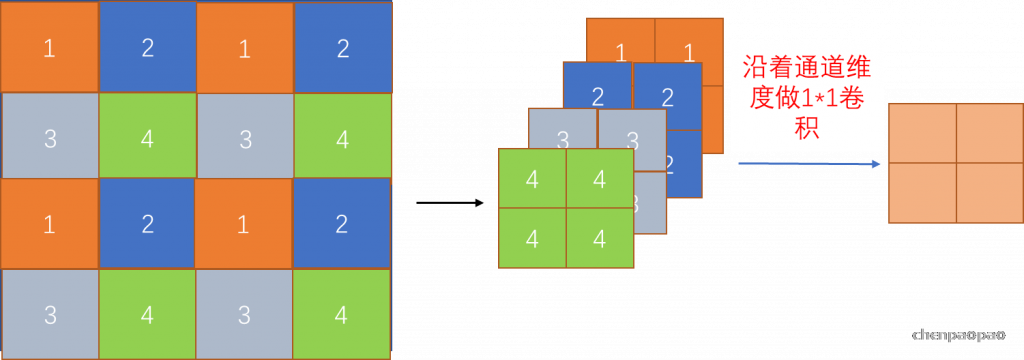
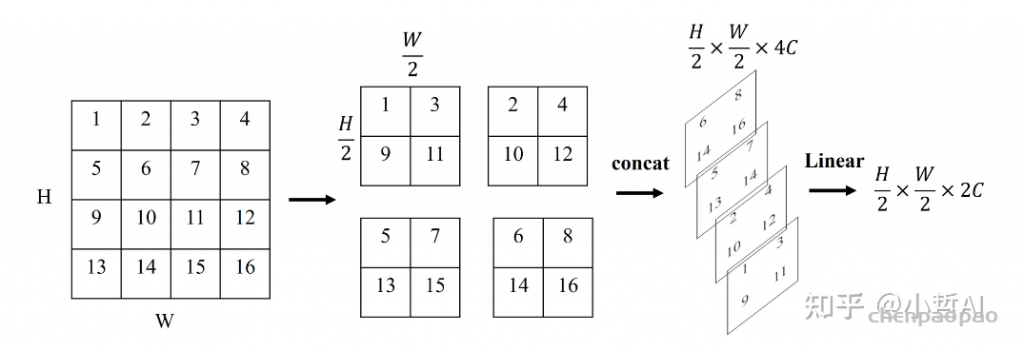
Block处理
SwinTransformerBlock的结构,由LayerNorm层、windowAttention层(Window MultiHead self -attention, W-MSA)、MLP层以及shiftWindowAttention层(SW-MSA)组成。

上面说到有两种block,block的代码如下:
class SwinTransformerBlock(nn.Module):
r""" Swin Transformer Block.
Args:
dim (int): Number of input channels.
input_resolution (tuple[int]): Input resulotion.
num_heads (int): Number of attention heads.
window_size (int): Window size.
shift_size (int): Shift size for SW-MSA.
mlp_ratio (float): Ratio of mlp hidden dim to embedding dim.
qkv_bias (bool, optional): If True, add a learnable bias to query, key, value. Default: True
qk_scale (float | None, optional): Override default qk scale of head_dim ** -0.5 if set.
drop (float, optional): Dropout rate. Default: 0.0
attn_drop (float, optional): Attention dropout rate. Default: 0.0
drop_path (float, optional): Stochastic depth rate. Default: 0.0
act_layer (nn.Module, optional): Activation layer. Default: nn.GELU
norm_layer (nn.Module, optional): Normalization layer. Default: nn.LayerNorm
"""
def __init__(self, dim, input_resolution, num_heads, window_size=7, shift_size=0,
mlp_ratio=4., qkv_bias=True, qk_scale=None, drop=0., attn_drop=0., drop_path=0.,
act_layer=nn.GELU, norm_layer=nn.LayerNorm):
super().__init__()
self.dim = dim
self.input_resolution = input_resolution
self.num_heads = num_heads
self.window_size = window_size
self.shift_size = shift_size
self.mlp_ratio = mlp_ratio
if min(self.input_resolution) <= self.window_size:
# if window size is larger than input resolution, we don't partition windows
self.shift_size = 0
self.window_size = min(self.input_resolution)
assert 0 <= self.shift_size < self.window_size, "shift_size must in 0-window_size"
# 左图中最下边的LN层layerNorm层
self.norm1 = norm_layer(dim)
# W_MSA层或者SW-MSA层,详细的介绍看WindowAttention部分的代码
self.attn = WindowAttention(
dim, window_size=to_2tuple(self.window_size), num_heads=num_heads,
qkv_bias=qkv_bias, qk_scale=qk_scale, attn_drop=attn_drop, proj_drop=drop)
self.drop_path = DropPath(drop_path) if drop_path > 0. else nn.Identity()
# 左图中间部分的LN层
self.norm2 = norm_layer(dim)
mlp_hidden_dim = int(dim * mlp_ratio)
# 左图最上边的MLP层
self.mlp = Mlp(in_features=dim, hidden_features=mlp_hidden_dim, act_layer=act_layer, drop=drop)
# 这里利用shift_size控制是否执行shift window操作
# 当shift_size为0时,不执行shift操作,对应W-MSA,也就是在每个stage中,W-MSA与SW-MSA交替出现
# 例如第一个stage中存在两个block,那么第一个shift_size=0就是W-MSA,第二个shift_size不为0
# 就是SW-MSA
if self.shift_size > 0:
# calculate attention mask for SW-MSA
H, W = self.input_resolution
img_mask = torch.zeros((1, H, W, 1)) # 1 H W 1
#slice() 函数实现切片对象,主要用在切片操作函数里的参数传递。class slice(start, stop[, step])
h_slices = (slice(0, -self.window_size),
slice(-self.window_size, -self.shift_size),
slice(-self.shift_size, None))
w_slices = (slice(0, -self.window_size),
slice(-self.window_size, -self.shift_size),
slice(-self.shift_size, None))
cnt = 0
for h in h_slices:
for w in w_slices:
img_mask[:, h, w, :] = cnt
cnt += 1
## 上述操作是为了给每个窗口给上索引
mask_windows = window_partition(img_mask, self.window_size) # nW, window_size, window_size, 1
mask_windows = mask_windows.view(-1, self.window_size * self.window_size)
attn_mask = mask_windows.unsqueeze(1) - mask_windows.unsqueeze(2)
attn_mask = attn_mask.masked_fill(attn_mask != 0, float(-100.0)).masked_fill(attn_mask == 0, float(0.0))
else:
attn_mask = None
self.register_buffer("attn_mask", attn_mask)
def forward(self, x):
H, W = self.input_resolution
B, L, C = x.shape
assert L == H * W, "input feature has wrong size"
shortcut = x
x = self.norm1(x)
x = x.view(B, H, W, C)
# cyclic shift
# 如果需要计算 SW-MSA就需要进行循环移位。
if self.shift_size > 0:
shifted_x = torch.roll(x, shifts=(-self.shift_size, -self.shift_size), dims=(1, 2))
else:
shifted_x = x
# partition windows
x_windows = window_partition(shifted_x, self.window_size) # nW*B, window_size, window_size, C
x_windows = x_windows.view(-1, self.window_size * self.window_size, C) # nW*B, window_size*window_size, C
# W-MSA/SW-MSA
attn_windows = self.attn(x_windows, mask=self.attn_mask) # nW*B, window_size*window_size, C
# merge windows
attn_windows = attn_windows.view(-1, self.window_size, self.window_size, C)
shifted_x = window_reverse(attn_windows, self.window_size, H, W) # B H' W' C
# reverse cyclic shift
if self.shift_size > 0:
#shifts (python:int 或 tuple of python:int) —— 张量元素移位的位数。如果该参数是一个元组(例如shifts=(x,y)),dims必须是一个相同大小的元组(例如dims=(a,b)),相当于在第a维度移x位,在b维度移y位
x = torch.roll(shifted_x, shifts=(self.shift_size, self.shift_size), dims=(1, 2))
else:
x = shifted_x
x = x.view(B, H * W, C)
# FFN
x = shortcut + self.drop_path(x)
x = x + self.drop_path(self.mlp(self.norm2(x)))
return x
def extra_repr(self) -> str:
return f"dim={self.dim}, input_resolution={self.input_resolution}, num_heads={self.num_heads}, " \
f"window_size={self.window_size}, shift_size={self.shift_size}, mlp_ratio={self.mlp_ratio}"
def flops(self):
flops = 0
H, W = self.input_resolution
# norm1
flops += self.dim * H * W
# W-MSA/SW-MSA
nW = H * W / self.window_size / self.window_size
flops += nW * self.attn.flops(self.window_size * self.window_size)
# mlp
flops += 2 * H * W * self.dim * self.dim * self.mlp_ratio
# norm2
flops += self.dim * H * W
return flopsW-MSA
W-MSA比较简单,只要其中shift_size设置为0就是W-MSA。下面跟着代码走一遍过程。
- 输入: x:B×562×96 , H,W=56
- 经过一层layerNorm
- 变形: x:B×56×56×96
- 直接赋值给
shifted_x - 调用
window_partition函数,输入shifted_x,window_size=7: - 注意窗口大小以patch为单位,比如7就是7个patch,如果56的分辨率就会有8个窗口。
- 这个函数对
shifted_x做一系列变形,最终变成 82B×7×7×96 - 返回赋值给
x_windows,再变形成 82B×72×96 ,这表示所有图片,每个图片的64个window,每个window内有49个patch。 - 调用
WindowAttention层,这里以它的num_head为3为例。输入参数为x_windows和self.attn_mask,对于W-MSA,attn_mask为None,可以不用管。
WindowAttention代码如下:
代码中使用7×7的windowsize,将feature map分割为不同的window,在每个window中计算自注意力。
Self-attention的计算公式(B为相对位置编码)

绝对位置编码是在进行self-attention计算之前为每一个token添加一个可学习的参数,相对位置编码如上式所示,是在进行self-attention计算时,在计算过程中添加一个可学习的相对位置参数。
假设window_size = 2*2即每个窗口有4个token (M=2) ,如图1所示,在计算self-attention时,每个token都要与所有的token计算QK值,如图6所示,当位置1的token计算self-attention时,要计算位置1与位置(1,2,3,4)的QK值,即以位置1的token为中心点,中心点位置坐标(0,0),其他位置计算与当前位置坐标的偏移量。




最后生成的是相对位置索引,relative_position_index.shape = (M2,M2) ,在网络中注册成为一个不可学习的变量,relative_position_index的作用就是根据最终的索引值找到对应的可学习的相对位置编码。relative_position_index的数值范围(0~8),即 (2M−1)∗(2M−1) ,所以相对位置编码(relative position bias table)可以由一个3*3的矩阵表示,如图7所示:这样就根据index对应位置的索引找到table对应位置的值作为相对位置编码。
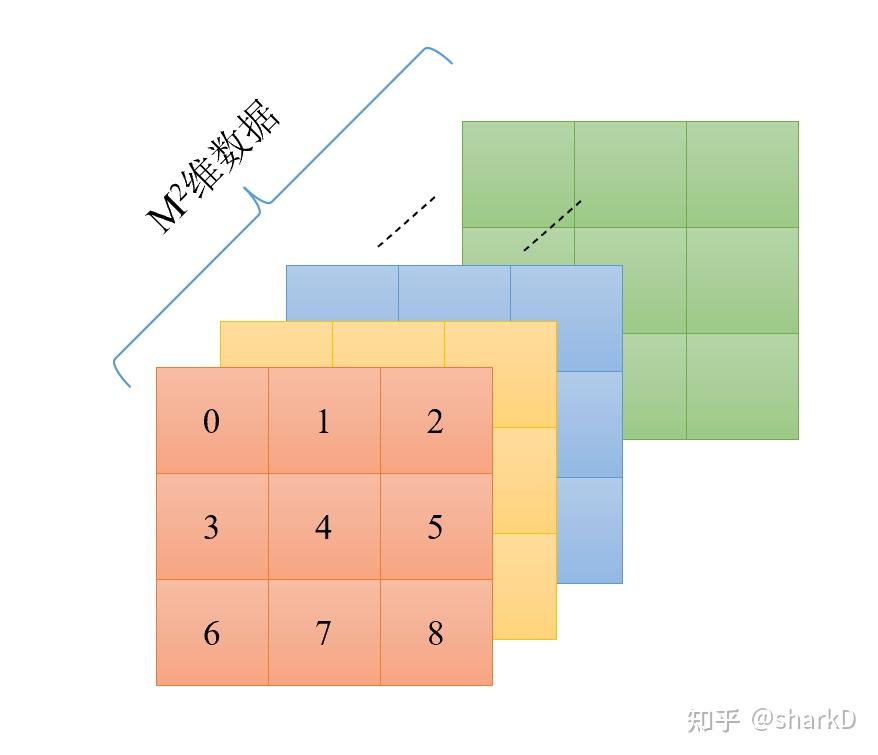
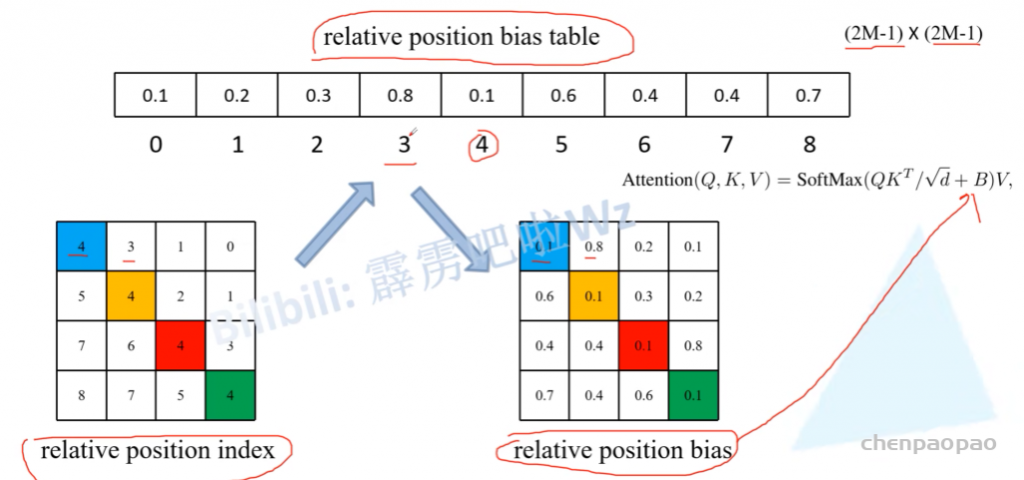
图7中的0-8为索引值,每个索引值都对应了 M2 维可学习数据(每个token都要计算 M2 个QK值,每个QK值都要加上对应的相对位置编码)
继续以图6中 M=2 的窗口为例,当计算位置1对应的 M2 个QK值时,应用的relative_position_index = [ 4, 5, 7, 8] (M2)个 ,对应的数据就是图7中位置索引4,5,7,8位置对应的 M2 维数据,即relative_position.shape = (M2∗M2)
相对位置编码在源码WindowAttention中应用,了解原理之后就很容易能够读懂程序:
class WindowAttention(nn.Module):
r""" Window based multi-head self attention (W-MSA) module with relative position bias.
It supports both of shifted and non-shifted window.
Args:
dim (int): Number of input channels.
window_size (tuple[int]): The height and width of the window.
num_heads (int): Number of attention heads.
qkv_bias (bool, optional): If True, add a learnable bias to query, key, value. Default: True
qk_scale (float | None, optional): Override default qk scale of head_dim ** -0.5 if set
attn_drop (float, optional): Dropout ratio of attention weight. Default: 0.0
proj_drop (float, optional): Dropout ratio of output. Default: 0.0
"""
def __init__(self, dim, window_size, num_heads, qkv_bias=True, qk_scale=None, attn_drop=0., proj_drop=0.):
super().__init__()
self.dim = dim # 输入通道的数量
self.window_size = window_size # Wh, Ww
self.num_heads = num_heads
head_dim = dim // num_heads
self.scale = qk_scale or head_dim ** -0.5
# define a parameter table of relative position bias
self.relative_position_bias_table = nn.Parameter(
torch.zeros((2 * window_size[0] - 1) * (2 * window_size[1] - 1), num_heads)) # 2*Wh-1 * 2*Ww-1, nH 初始化表
# get pair-wise relative position index for each token inside the window
coords_h = torch.arange(self.window_size[0]) # coords_h = tensor([0,1,2,...,self.window_size[0]-1]) 维度=Wh
coords_w = torch.arange(self.window_size[1]) # coords_w = tensor([0,1,2,...,self.window_size[1]-1]) 维度=Ww
coords = torch.stack(torch.meshgrid([coords_h, coords_w])) # 2, Wh, Ww
coords_flatten = torch.flatten(coords, 1) # 2, Wh*Ww
relative_coords = coords_flatten[:, :, None] - coords_flatten[:, None, :] # 2, Wh*Ww, Wh*Ww
relative_coords = relative_coords.permute(1, 2, 0).contiguous() # Wh*Ww, Wh*Ww, 2
relative_coords[:, :, 0] += self.window_size[0] - 1 # shift to start from 0
relative_coords[:, :, 1] += self.window_size[1] - 1
'''
后面我们需要将其展开成一维偏移量。而对于(2,1)和(1,2)这两个坐标,在二维上是不同的,但是通过将x\y坐标相加转换为一维偏移的时候
他们的偏移量是相等的,所以需要对其做乘法操作,进行区分
'''
relative_coords[:, :, 0] *= 2 * self.window_size[1] - 1
# 计算得到相对位置索引
# relative_position_index.shape = (M2, M2) 意思是一共有这么多个位置
relative_position_index = relative_coords.sum(-1) # Wh*Ww, Wh*Ww
'''
relative_position_index注册为一个不参与网络学习的变量
'''
self.register_buffer("relative_position_index", relative_position_index)
self.qkv = nn.Linear(dim, dim * 3, bias=qkv_bias)
self.attn_drop = nn.Dropout(attn_drop)
self.proj = nn.Linear(dim, dim)
self.proj_drop = nn.Dropout(proj_drop)
'''
使用从截断正态分布中提取的值填充输入张量
self.relative_position_bias_table 是全0张量,通过trunc_normal_ 进行数值填充
'''
trunc_normal_(self.relative_position_bias_table, std=.02)
self.softmax = nn.Softmax(dim=-1)
def forward(self, x, mask=None):
"""
Args:
x: input features with shape of (num_windows*B, N, C)
N: number of all patches in the window
C: 输入通过线性层转化得到的维度C
mask: (0/-inf) mask with shape of (num_windows, Wh*Ww, Wh*Ww) or None
"""
B_, N, C = x.shape
'''
x.shape = (num_windows*B, N, C)
self.qkv(x).shape = (num_windows*B, N, 3C)
self.qkv(x).reshape(B_, N, 3, self.num_heads, C // self.num_heads).shape = (num_windows*B, N, 3, num_heads, C//num_heads)
self.qkv(x).reshape(B_, N, 3, self.num_heads, C // self.num_heads).permute(2, 0, 3, 1, 4).shape = (3, num_windows*B, num_heads, N, C//num_heads)
'''
qkv = self.qkv(x).reshape(B_, N, 3, self.num_heads, C // self.num_heads).permute(2, 0, 3, 1, 4)
'''
q.shape = k.shape = v.shape = (num_windows*B, num_heads, N, C//num_heads)
N = M2 代表patches的数量
C//num_heads代表Q,K,V的维数
'''
q, k, v = qkv[0], qkv[1], qkv[2] # make torchscript happy (cannot use tensor as tuple)
# q乘上一个放缩系数,对应公式中的sqrt(d)
q = q * self.scale
# attn.shape = (num_windows*B, num_heads, N, N) N = M2 代表patches的数量
attn = (q @ k.transpose(-2, -1))
'''
self.relative_position_bias_table.shape = (2*Wh-1 * 2*Ww-1, nH)
self.relative_position_index.shape = (Wh*Ww, Wh*Ww)
self.relative_position_index矩阵中的所有值都是从self.relative_position_bias_table中取的
self.relative_position_index是计算出来不可学习的量
'''
relative_position_bias = self.relative_position_bias_table[self.relative_position_index.view(-1)].view(
self.window_size[0] * self.window_size[1], self.window_size[0] * self.window_size[1], -1) # Wh*Ww,Wh*Ww,nH
relative_position_bias = relative_position_bias.permute(2, 0, 1).contiguous() # nH, Wh*Ww, Wh*Ww
'''
attn.shape = (num_windows*B, num_heads, M2, M2) N = M2 代表patches的数量
.unsqueeze(0):扩张维度,在0对应的位置插入维度1
relative_position_bias.unsqueeze(0).shape = (1, num_heads, M2, M2)
num_windows*B 通过广播机制传播,relative_position_bias.unsqueeze(0).shape = (1, nH, M2, M2) 的维度1会broadcast到数量num_windows*B
表示所有batch通用一个索引矩阵和相对位置矩阵
'''
attn = attn + relative_position_bias.unsqueeze(0)
# mask.shape = (num_windows, M2, M2)
# attn.shape = (num_windows*B, num_heads, M2, M2)
if mask is not None:
nW = mask.shape[0]
# attn.view(B_ // nW, nW, self.num_heads, N, N).shape = (B, num_windows, num_heads, M2, M2) 第一个M2代表有M2个token,第二个M2代表每个token要计算M2次QKT的值
# mask.unsqueeze(1).unsqueeze(0).shape = (1, num_windows, 1, M2, M2) 第一个M2代表有M2个token,第二个M2代表每个token要计算M2次QKT的值
# broadcast相加
attn = attn.view(B_ // nW, nW, self.num_heads, N, N) + mask.unsqueeze(1).unsqueeze(0)
# attn.shape = (B, num_windows, num_heads, M2, M2)
attn = attn.view(-1, self.num_heads, N, N)
attn = self.softmax(attn)
else:
attn = self.softmax(attn)
attn = self.attn_drop(attn)
'''
v.shape = (num_windows*B, num_heads, M2, C//num_heads) N=M2 代表patches的数量, C//num_heads代表输入的维度
attn.shape = (num_windows*B, num_heads, M2, M2)
attn@v .shape = (num_windows*B, num_heads, M2, C//num_heads)
'''
x = (attn @ v).transpose(1, 2).reshape(B_, N, C) # B_:num_windows*B N:M2 C=num_heads*C//num_heads
# self.proj = nn.Linear(dim, dim) dim = C
# self.proj_drop = nn.Dropout(proj_drop)
x = self.proj(x)
x = self.proj_drop(x)
return x # x.shape = (num_windows*B, N, C) N:窗口中所有patches的数量
def extra_repr(self) -> str:
return f'dim={self.dim}, window_size={self.window_size}, num_heads={self.num_heads}'
def flops(self, N):
# calculate flops for 1 window with token length of N
flops = 0
# qkv = self.qkv(x)
flops += N * self.dim * 3 * self.dim
# attn = (q @ k.transpose(-2, -1))
flops += self.num_heads * N * (self.dim // self.num_heads) * N
# x = (attn @ v)
flops += self.num_heads * N * N * (self.dim // self.num_heads)
# x = self.proj(x)
flops += N * self.dim * self.dim
return flops在上述程序中有一段mask相关程序:
if mask is not None:
nW = mask.shape[0]
# attn.view(B_ // nW, nW, self.num_heads, N, N).shape = (B, num_windows, num_heads, M2, M2) 第一个M2代表有M2个token,第二个M2代表每个token要计算M2次QKT的值
# mask.unsqueeze(1).unsqueeze(0).shape = (1, num_windows, 1, M2, M2) 第一个M2代表有M2个token,第二个M2代表每个token要计算M2次QKT的值
# broadcast相加
attn = attn.view(B_ // nW, nW, self.num_heads, N, N) + mask.unsqueeze(1).unsqueeze(0)
# attn.shape = (B, num_windows, num_heads, M2, M2)
attn = attn.view(-1, self.num_heads, N, N)
attn = self.softmax(attn)
else:
attn = self.softmax(attn)这个部分对应的是Swin Transformer Block 中的SW-MSA
- 输入 x:82B×72×96 。
- 产生 QKV ,调用线性层后,得到 82B×72×(96×3) ,拆分给不同的head,得到 82B×72×3×3×32 ,第一个3是 QKV 的3,第二个3是3个head。再permute成 3×82B×3×72×32 ,再拆解成 q,k,v ,每个都是 82B×3×72×32 。表示所有图片的每个图片64个window,每个window对应到3个不同的head,都有一套49个patch、32维的特征。
- q 归一化
- qk 矩阵相乘求特征内积,得到 attn:82B×3×72×72
- 得到相对位置的编码信息
relative_position_bias:- 代码如下:
self.relative_position_bias_table = nn.Parameter(
torch.zeros((2 * window_size[0] - 1) * (2 * window_size[1] - 1), num_heads)) # 2*Wh-1 * 2*Ww-1, nH
# get pair-wise relative position index for each token inside the window
coords_h = torch.arange(self.window_size[0])
coords_w = torch.arange(self.window_size[1])
coords = torch.stack(torch.meshgrid([coords_h, coords_w])) # 2, Wh, Ww
coords_flatten = torch.flatten(coords, 1) # 2, Wh*Ww
relative_coords = coords_flatten[:, :, None] - coords_flatten[:, None, :] # 2, Wh*Ww, Wh*Ww
relative_coords = relative_coords.permute(1, 2, 0).contiguous() # Wh*Ww, Wh*Ww, 2
relative_coords[:, :, 0] += self.window_size[0] - 1 # shift to start from 0
relative_coords[:, :, 1] += self.window_size[1] - 1
relative_coords[:, :, 0] *= 2 * self.window_size[1] - 1
relative_position_index = relative_coords.sum(-1) # Wh*Ww, Wh*Ww
self.register_buffer("relative_position_index", relative_position_index)- 这里以
window_size=3为例,解释以下过程:首先生成 coords:2×3×3 ,就是在一个 3×3 的窗口内,每个位置的 y,x 坐标,而relative_coords为 2×9×9 ,就是9个点中,每个点的 y 或 x 与其他所有点的差值,比如 [0][3][1] 表示3号点(第二行第一个点)与1号点(第一行第二个点)的 y 坐标的差值。然后变形,并让两个坐标分别加上 3−1=2 ,是因为这些坐标值范围 [0,2] ,因此差值的最小值为-2,加上2后从0开始。最后让 y 坐标乘上 2×3−1=5 ,应该是一个trick,调整差值范围。最后将两个维度的差值相加,得到relative_position_index, 32×32 ,为9个点之间两两之间的相对位置编码值,最后用来到self.relative_position_bias_table中寻址,注意相对位置的最大值为 (2M−2)(2M−1) ,而这个table最多有 (2M−1)(2M−1) 行,因此保证可以寻址,得到了一组给多个head使用的相对位置编码信息,这个table是可训练的参数。 - 回到代码中,得到的
relative_position_bias为 3×72×72 - 将其加到
attn上,最后一个维度softmax,dropout - 与 v 矩阵相乘,并转置,合并多个头的信息,得到 82B×72×96
- 经过一层线性层,dropout,返回
- 返回赋值给
attn_windows,变形为 82B×7×7×96 - 调用
window_reverse,打回原状: B×56×56×96 - 返回给 x ,经过FFN:先加上原来的输入 x 作为residue结构,注意这里用到timm的
DropPath,并且drop的概率是整个网络结构线性增长的。然后再加上两层mlp的结果。 - 返回结果 x 。
这样,整个过程就完成了,剩下的就是SW-MSA的一些不同的操作。

- 首先将windows进行半个窗口的循环移位,上图中的1, 2步骤,使用torch.roll实现。
- 在相同的窗口中计算自注意力,计算结果如下右图所示,window0的结构保存,但是针对window2的计算,其中3与3、6与6的计算生成了attn mask 中window2中的黄色区域,针对windows2中3与6、6与3之间不应该计算自注意力(attn mask中window2的蓝色区域),将蓝色区域mask赋值为-100,经过softmax之后,起作用可以忽略不计。同理window1与window3的计算一致。
- 最后再进行循环移位,恢复原来的位置。
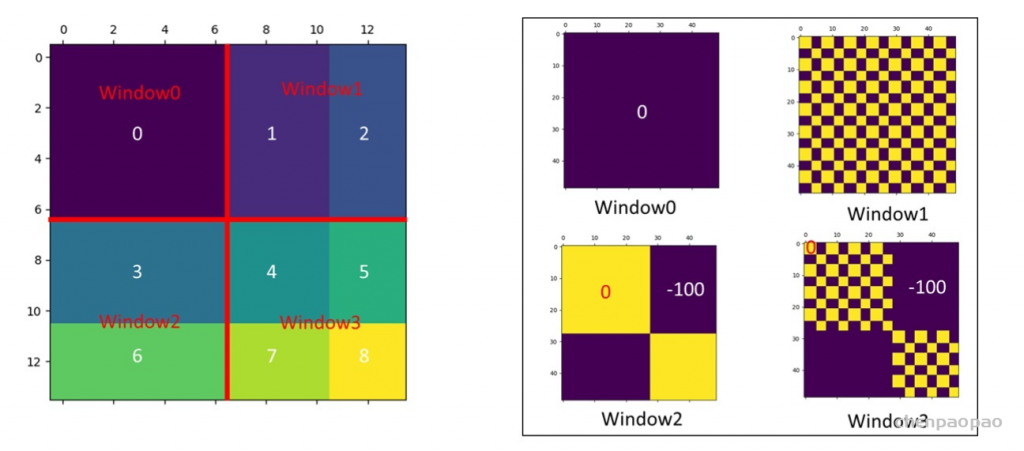
原论文图中的Stage和程序中的一个Stage不同:
程序中的BasicLayer为一个Stage,在BasicLayer中调用了上面讲到的SwinTransformerBlock和PatchMerging模块:
class BasicLayer(nn.Module): # 论文图中每个stage里对应的若干个SwinTransformerBlock
""" A basic Swin Transformer layer for one stage.
Args:
dim (int): Number of input channels.
input_resolution (tuple[int]): Input resolution.
depth (int): Number of blocks.
num_heads (int): Number of attention heads.
window_size (int): Local window size.
mlp_ratio (float): Ratio of mlp hidden dim to embedding dim.
qkv_bias (bool, optional): If True, add a learnable bias to query, key, value. Default: True
qk_scale (float | None, optional): Override default qk scale of head_dim ** -0.5 if set.
drop (float, optional): Dropout rate. Default: 0.0
attn_drop (float, optional): Attention dropout rate. Default: 0.0
drop_path (float | tuple[float], optional): Stochastic depth rate. Default: 0.0
norm_layer (nn.Module, optional): Normalization layer. Default: nn.LayerNorm
downsample (nn.Module | None, optional): Downsample layer at the end of the layer. Default: None
use_checkpoint (bool): Whether to use checkpointing to save memory. Default: False.
"""
def __init__(self, dim, input_resolution, depth, num_heads, window_size,
mlp_ratio=4., qkv_bias=True, qk_scale=None, drop=0., attn_drop=0.,
drop_path=0., norm_layer=nn.LayerNorm, downsample=None, use_checkpoint=False):
super().__init__()
self.dim = dim
self.input_resolution = input_resolution
self.depth = depth # swin_transformer blocks的个数
self.use_checkpoint = use_checkpoint
# build blocks 从0开始的偶数位置的SwinTransformerBlock计算的是W-MSA,奇数位置的Block计算的是SW-MSA,且shift_size = window_size//2
self.blocks = nn.ModuleList([
SwinTransformerBlock(dim=dim, input_resolution=input_resolution,
num_heads=num_heads, window_size=window_size,
shift_size=0 if (i % 2 == 0) else window_size // 2,
mlp_ratio=mlp_ratio,
qkv_bias=qkv_bias, qk_scale=qk_scale,
drop=drop, attn_drop=attn_drop,
drop_path=drop_path[i] if isinstance(drop_path, list) else drop_path,
norm_layer=norm_layer)
for i in range(depth)])
# patch merging layer
if downsample is not None:
self.downsample = downsample(input_resolution, dim=dim, norm_layer=norm_layer)
else:
self.downsample = None
def forward(self, x):
for blk in self.blocks:
if self.use_checkpoint:
x = checkpoint.checkpoint(blk, x)
else:
x = blk(x) # blk = SwinTransformerBlock
if self.downsample is not None:
x = self.downsample(x)
return x
def extra_repr(self) -> str:
return f"dim={self.dim}, input_resolution={self.input_resolution}, depth={self.depth}"
def flops(self):
flops = 0
for blk in self.blocks:
flops += blk.flops()
if self.downsample is not None:
flops += self.downsample.flops()
return flopsPart 3 : 不同视觉任务输出
程序中对应的是图片分类任务,经过Part 2 之后的数据通过 norm/avgpool/flatten:
x = self.norm(x) # B L C
x = self.avgpool(x.transpose(1, 2)) # B C 1
x = torch.flatten(x, 1) # B C之后通过nn.Linear将特征转化为对应的类别:
self.head = nn.Linear(self.num_features, num_classes) if num_classes > 0 else nn.Identity()应用于其他不同的视觉任务时,只需要将输出进行特定的修改即可。
完整的SwinTransformer程序如下:
class SwinTransformer(nn.Module):
r""" Swin Transformer
A PyTorch impl of : `Swin Transformer: Hierarchical Vision Transformer using Shifted Windows` -
https://arxiv.org/pdf/2103.14030
Args:
img_size (int | tuple(int)): Input image size. Default 224
patch_size (int | tuple(int)): Patch size. Default: 4
in_chans (int): Number of input image channels. Default: 3
num_classes (int): Number of classes for classification head. Default: 1000
embed_dim (int): Patch embedding dimension. Default: 96
depths (tuple(int)): Depth of each Swin Transformer layer.
num_heads (tuple(int)): Number of attention heads in different layers.
window_size (int): Window size. Default: 7
mlp_ratio (float): Ratio of mlp hidden dim to embedding dim. Default: 4
qkv_bias (bool): If True, add a learnable bias to query, key, value. Default: True
qk_scale (float): Override default qk scale of head_dim ** -0.5 if set. Default: None
drop_rate (float): Dropout rate. Default: 0
attn_drop_rate (float): Attention dropout rate. Default: 0
drop_path_rate (float): Stochastic depth rate. Default: 0.1
norm_layer (nn.Module): Normalization layer. Default: nn.LayerNorm.
ape (bool): If True, add absolute position embedding to the patch embedding. Default: False
patch_norm (bool): If True, add normalization after patch embedding. Default: True
use_checkpoint (bool): Whether to use checkpointing to save memory. Default: False
"""
def __init__(self, img_size=224, patch_size=4, in_chans=3, num_classes=1000,
embed_dim=96, depths=[2, 2, 6, 2], num_heads=[3, 6, 12, 24],
window_size=7, mlp_ratio=4., qkv_bias=True, qk_scale=None,
drop_rate=0., attn_drop_rate=0., drop_path_rate=0.1,
norm_layer=nn.LayerNorm, ape=False, patch_norm=True,
use_checkpoint=False, **kwargs):
super().__init__()
self.num_classes = num_classes # 1000
self.num_layers = len(depths) # [2, 2, 6, 2] Swin_T 的配置
self.embed_dim = embed_dim # 96
self.ape = ape # False
self.patch_norm = patch_norm # True
self.num_features = int(embed_dim * 2 ** (self.num_layers - 1)) # 96*2^3
self.mlp_ratio = mlp_ratio # 4
# split image into non-overlapping patches
self.patch_embed = PatchEmbed(
img_size=img_size, patch_size=patch_size, in_chans=in_chans, embed_dim=embed_dim,
norm_layer=norm_layer if self.patch_norm else None)
num_patches = self.patch_embed.num_patches
patches_resolution = self.patch_embed.patches_resolution
self.patches_resolution = patches_resolution
# absolute position embedding
if self.ape:
self.absolute_pos_embed = nn.Parameter(torch.zeros(1, num_patches, embed_dim))
trunc_normal_(self.absolute_pos_embed, std=.02)
self.pos_drop = nn.Dropout(p=drop_rate)
# stochastic depth
dpr = [x.item() for x in torch.linspace(0, drop_path_rate, sum(depths))] # stochastic depth decay rule
# build layers
self.layers = nn.ModuleList()
for i_layer in range(self.num_layers):
layer = BasicLayer(dim=int(embed_dim * 2 ** i_layer),
input_resolution=(patches_resolution[0] // (2 ** i_layer),
patches_resolution[1] // (2 ** i_layer)),
depth=depths[i_layer],
num_heads=num_heads[i_layer],
window_size=window_size,
mlp_ratio=self.mlp_ratio,
qkv_bias=qkv_bias, qk_scale=qk_scale,
drop=drop_rate, attn_drop=attn_drop_rate,
drop_path=dpr[sum(depths[:i_layer]):sum(depths[:i_layer + 1])],
norm_layer=norm_layer,
downsample=PatchMerging if (i_layer < self.num_layers - 1) else None,
use_checkpoint=use_checkpoint)
self.layers.append(layer)
self.norm = norm_layer(self.num_features) # norm_layer = nn.LayerNorm
self.avgpool = nn.AdaptiveAvgPool1d(1)
self.head = nn.Linear(self.num_features, num_classes) if num_classes > 0 else nn.Identity()
self.apply(self._init_weights) # 使用self.apply 初始化参数
def _init_weights(self, m):
# is_instance 判断对象是否为已知类型
if isinstance(m, nn.Linear):
trunc_normal_(m.weight, std=.02)
if isinstance(m, nn.Linear) and m.bias is not None:
nn.init.constant_(m.bias, 0)
elif isinstance(m, nn.LayerNorm):
nn.init.constant_(m.bias, 0)
nn.init.constant_(m.weight, 1.0)
@torch.jit.ignore
def no_weight_decay(self):
return {'absolute_pos_embed'}
@torch.jit.ignore
def no_weight_decay_keywords(self):
return {'relative_position_bias_table'}
def forward_features(self, x):
x = self.patch_embed(x) # x.shape = (H//4, W//4, C)
if self.ape:
x = x + self.absolute_pos_embed
x = self.pos_drop(x) # self.pos_drop = nn.Dropout(p=drop_rate)
for layer in self.layers:
x = layer(x)
x = self.norm(x) # B L C
x = self.avgpool(x.transpose(1, 2)) # B C 1
x = torch.flatten(x, 1) # B C
return x
def forward(self, x):
x = self.forward_features(x) # x是论文图中Figure 3 a图中最后的输出
# self.head = nn.Linear(self.num_features, num_classes) if num_classes > 0 else nn.Identity()
x = self.head(x) # x.shape = (B, num_classes)
return x
def flops(self):
flops = 0
flops += self.patch_embed.flops()
for i, layer in enumerate(self.layers):
flops += layer.flops()
flops += self.num_features * self.patches_resolution[0] * self.patches_resolution[1] // (2 ** self.num_layers)
flops += self.num_features * self.num_classes
return flops补充:有关swin transformer相对位置编码:
